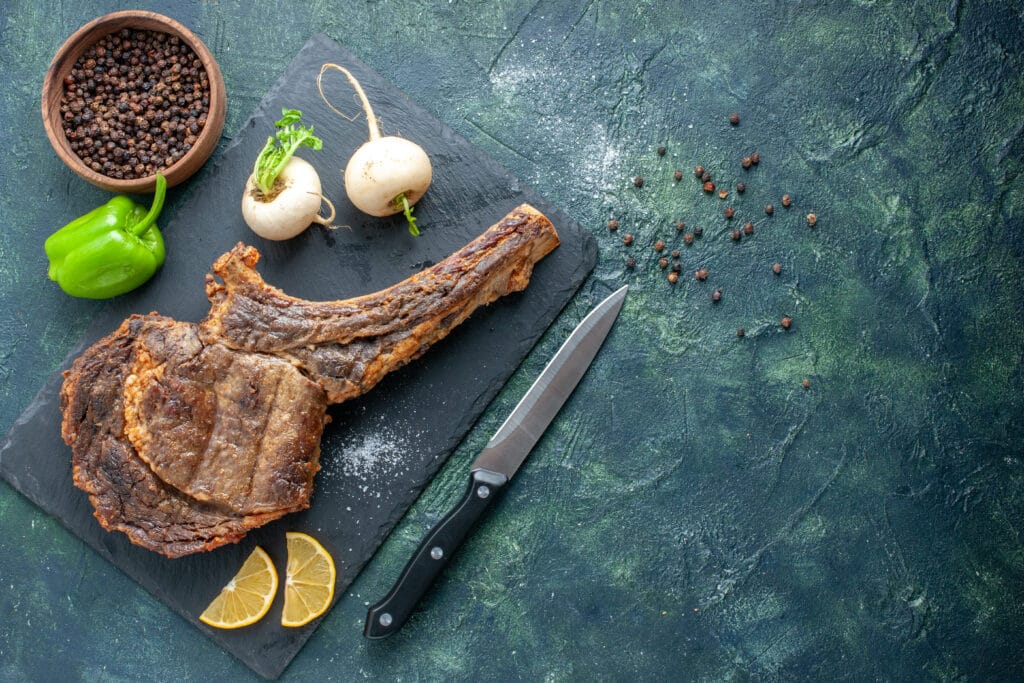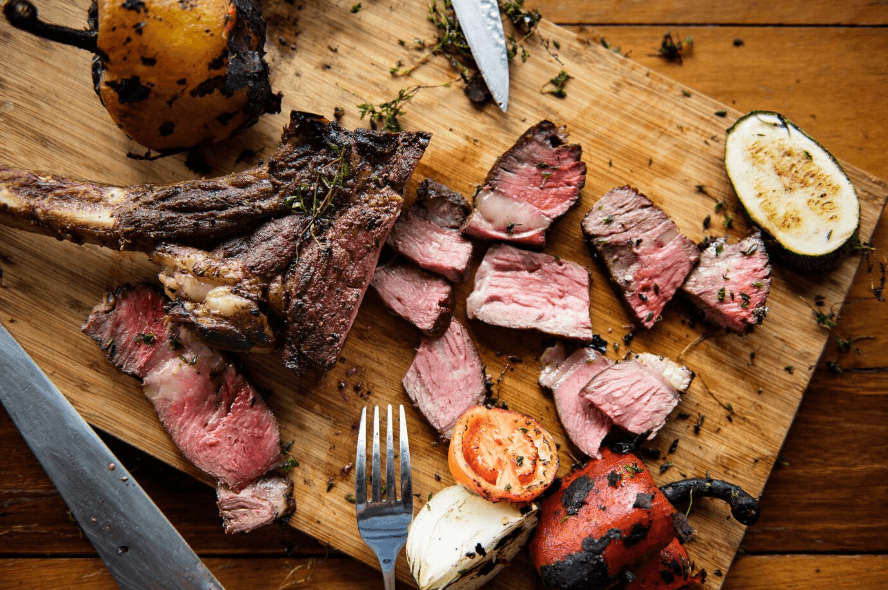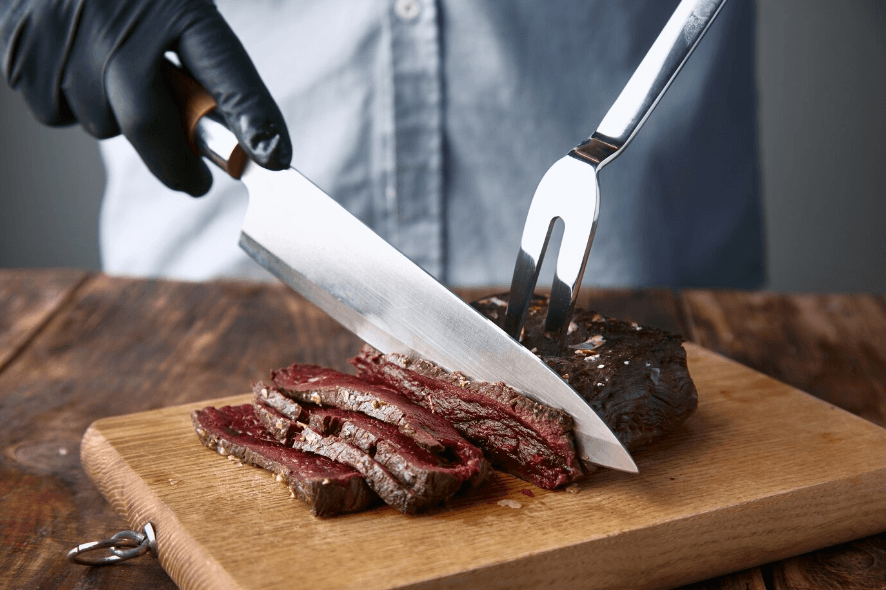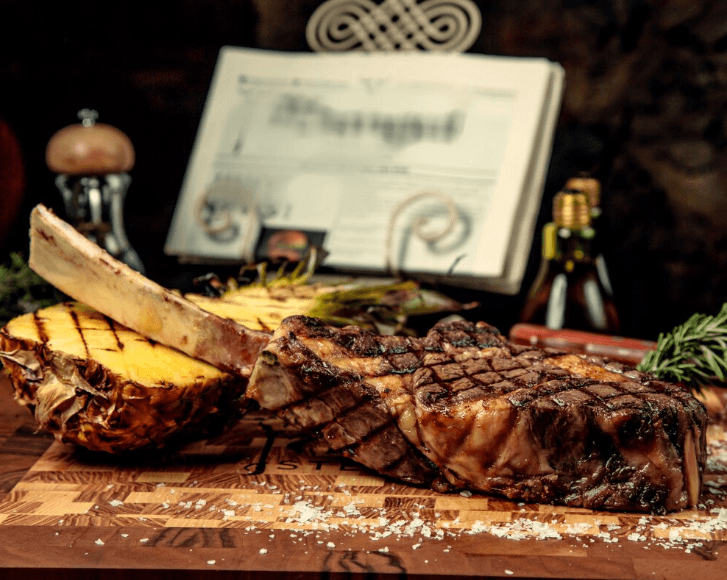What is a Tomahawk Steak?
When it comes to premium steaks, the Tomahawk steak is definitely in a league of its own. It’s known for its impressive size, dramatic presentation, and deliciously marbled meat. You may have seen it served at high-end steakhouses or featured in Instagram photos, but what exactly makes the Tomahawk steak so special? Let’s dive into what this cut is all about and explore how it stands apart from other steaks, like the Cowboy steak.
The Tomahawk Steak Defined
The tomahawk steak is a bone-in ribeye with a long, frenched bone that extends 6-8 inches. This gives it a striking “axe-like” appearance. The cut comes from the rib section and is known for its rich marbling, which adds tenderness and flavor. Weighing 30-45 ounces, it’s perfect for grilling, making it a juicy, flavorful showstopper.
The tomahawk steak is a bone-in ribeye that stands out due to its long, frenched bone, resembling a tomahawk axe. It’s often mistaken for the cowboy steak, but the two have subtle differences. If you’re curious about how these steaks compare, check out this article: Are tomahawk and cowboy steak the same thing?.
The Origin of the Tomahawk Steak
The Tomahawk steak isn’t a new invention. It gained popularity due to its dramatic presentation and ability to feed a crowd. The name comes from the long bone left attached to the steak, which resembles a tomahawk axe. While this steak is commonly associated with modern steakhouses and high-end restaurants, it originally came from the ribeye cut, a classic favorite among beef lovers.
As it became more popular in upscale dining, chefs began to embrace the Tomahawk steak not just for its flavor but for its eye-catching look. It’s often a centerpiece at special occasions like birthdays or holiday dinners.
How to Cook a Tomahawk Steak
Cooking a Tomahawk steak can feel a bit intimidating because of its size, but don’t worry it’s simpler than it looks. Here are a few methods that work best for cooking this giant cut of beef:
- Grilling: This is perhaps the most popular method for cooking a Tomahawk steak. The high heat from the grill caramelizes the outer layer, while the inside stays juicy and tender. For optimal results, use direct heat to sear the steak and then move it to indirect heat to finish cooking to your preferred doneness.
- Reverse Searing: If you want to get that perfect crust without overcooking the interior, reverse searing is a great option. Start by cooking the steak in a low-temperature oven (around 250°F) until it’s nearly at the desired internal temperature. Then, finish it off by searing it on a hot grill or pan for that crispy exterior.
- Oven-Baking: If grilling isn’t an option, you can always bake your Tomahawk steak in the oven. Sear it first in a hot pan to develop that golden crust, then transfer it to a preheated oven to cook to your desired level of doneness.
When it comes to seasoning, a simple salt-and-pepper rub works wonders, but you can also marinate it in your favorite mix of herbs, garlic, and olive oil. The key is to give the steak time to rest after cooking this lets the juices redistribute, ensuring every bite is as tender and flavorful as possible.
The Flavor Profile of a Tomahawk Steak
What really sets the Tomahawk steak apart is its flavor. Thanks to the marbling in the meat, each bite is rich and juicy. The fat renders beautifully as it cooks, creating a melt-in-your-mouth experience. It’s tender, yet hearty, and has the signature beefy taste that ribeye lovers crave.
Because of the bone and the extra fat, Tomahawk steaks have a deeper, more robust flavor than leaner cuts like the tenderloin. The fat also imparts a smoky, savory taste when grilled or seared, making this steak a top choice for barbecue enthusiasts.
What is a Cowboy Steak?

While the Tomahawk steak is often the showstopper, the Cowboy steak has its own loyal following. It’s similar in many ways but has its unique characteristics that distinguish it from its ribeye cousins. If you’re curious about how the Cowboy steak compares to the Tomahawk, this part will give you all the juicy details.
The Cowboy Steak Defined
A Cowboy steak is essentially a bone-in ribeye, just like the Tomahawk, but with a shorter bone. It’s also sometimes referred to as a “bone-in ribeye” due to its close relationship to the ribeye cut, which comes from the rib section of the cow. The Cowboy steak is typically cut thicker than most other ribeye steaks, usually around 1.5 to 2 inches thick, ensuring a juicy, flavorful experience.
What sets the Cowboy steak apart is its bone structure. The bone is typically 4-6 inches long, which is much shorter than the Tomahawk steak’s signature long bone. This makes the Cowboy steak a little more manageable for those who want the bone-in experience but with a more practical approach. However, despite the smaller bone, the Cowboy steak still retains the same tender, marbled meat that makes ribeye steaks so desirable.
The Origin of the Cowboy Steak
While the name “Cowboy steak” evokes images of the Old West and rugged cowboys, this cut is actually a modern take on the ribeye. The term “Cowboy” likely refers to the steak’s rustic appearance, making it a great choice for grilling over open flames, a cooking method beloved by cowboys in days gone by.
The Cowboy steak is relatively new to the mainstream, gaining popularity alongside other bone-in cuts like the Tomahawk. It’s typically found in steakhouses or on menus that offer classic cuts with a bit of flair. Much like the Tomahawk, the Cowboy steak is often reserved for special occasions due to its size, flavor, and presentation.
How to Cook a Cowboy Steak
Cooking a Cowboy steak requires a similar approach to that of the Tomahawk steak. You want to bring out the best in this cut, which means using high heat to create a beautiful sear while ensuring the inside remains juicy and tender.
- Grilling: Grilling is a popular method for cooking Cowboy steaks. Whether you’re using a charcoal grill or gas, you can sear the steak over direct heat to get that golden-brown crust, then move it to indirect heat to finish cooking. This helps to keep the steak juicy and tender.
- Pan-Seared & Oven-Finished: Another option is to start by searing the Cowboy steak in a hot pan, creating a crust on both sides. Then, transfer the steak to a preheated oven to cook through. This method is great for achieving that perfect medium-rare doneness.
- Reverse Searing: Reverse searing works well for thicker Cowboy steaks. This method involves cooking the steak at a low temperature in the oven, then finishing it with a quick sear in a hot pan or on the grill. The result is a beautifully cooked steak with a crisp, flavorful crust.
The Flavor Profile of a Cowboy Steak
The Cowboy steak offers a flavor profile that’s nearly identical to the Tomahawk steak. Both cuts are rich, juicy, and bursting with beefy goodness. The Cowboy steak’s marbling provides plenty of fat that renders as the steak cooks, creating a juicy, melt-in-your-mouth experience.
However, since the bone is shorter than in a Tomahawk, some argue that the Cowboy steak has a slightly more concentrated beef flavor. The bone can still enhance the taste, especially if you cook it on the grill or in a cast-iron skillet, as the marrow adds depth to the flavor.
While the Tomahawk steak is known for its bold, dramatic presentation, the Cowboy steak is more about the pure taste of beef. It’s a hearty cut, with just the right balance of tenderness and flavor, making it a great choice for those who prefer a straightforward, no-nonsense steak.
Key Differences Between Tomahawk and Cowboy Steaks
Now that we’ve broken down the individual characteristics of both the Tomahawk and Cowboy steaks, it’s time to compare these two popular cuts. Though they share similarities, there are key differences that set them apart. In this part, we’ll dive deep into the factors that distinguish these two steaks in terms of size, presentation, flavor, and more.
Size and Presentation
The Tomahawk and Cowboy steaks differ mainly in size and bone length. The Tomahawk is known for its massive, eye-catching presentation, with a long frenched bone that can extend up to 8 inches, giving it an “axe-like” appearance.
In contrast, the Cowboy steak has a shorter bone, usually around 4–6 inches. While it still offers a bone-in experience and a thick, flavorful cut, it’s easier to manage for those seeking a hearty steak without the dramatic presentation.
The Tomahawk’s longer bone affects heat distribution, making it harder to cook evenly, especially when grilling or reverse-searing. On the other hand, the Cowboy steak, with its shorter bone, cooks more quickly and evenly, offering easier control over doneness.
Cooking Time and Difficulty
Due to its larger size, the Tomahawk steak typically requires a longer cooking time than the Cowboy steak. The thick meat and long bone make it necessary to use indirect heat for a longer period of time, which helps ensure the inside reaches the desired temperature without overcooking the exterior.
Conversely, the Cowboy steak’s shorter bone means it cooks faster. You can use direct heat methods like grilling or pan-searing without having to worry about overcooking the inside. Whether you’re grilling, pan-searing, or reverse searing, the Cowboy steak offers a more straightforward cooking process.
If you’re new to cooking steaks, the Cowboy steak might be the better choice since it’s more forgiving when it comes to cooking time. The Tomahawk steak, while impressive, requires a little more attention and skill to ensure it cooks evenly throughout, especially if you’re aiming for a specific doneness.
Flavor and Tenderness
Both the Tomahawk and Cowboy steaks come from the rib section, giving them similar flavor profiles. Both are marbled with fat, making them tender and juicy. However, the Tomahawk, with its longer bone and larger size, often has a more pronounced beefy taste due to the bone marrow and extra fat rendered during cooking.
The Cowboy steak, with its shorter bone, may have a more concentrated flavor. While it lacks the influence of marrow, the meat remains tender and juicy. Its smaller size allows for better heat penetration, making it easier to achieve perfect doneness.
If you prefer a more intense beef flavor, the Tomahawk might be the better pick. For a balanced, tender bite, the Cowboy steak could be ideal.
Price and Availability
Another key difference between the Tomahawk and Cowboy steaks is the price. Due to its larger size, dramatic presentation, and the extra butchering required to leave the bone exposed, the Tomahawk steak tends to be more expensive. It’s often considered a premium cut, typically priced higher than other steaks, including the Cowboy steak.
The Cowboy steak, on the other hand, is usually more affordable. Although it’s still a premium cut of meat, its shorter bone and smaller size make it more cost-effective compared to the Tomahawk. It’s a great option for those who want the ribeye experience without breaking the bank.
Both steaks are typically available at butcher shops, high-end grocery stores, and steakhouses, but the Tomahawk is less common and may need to be specially ordered in some cases.
Serving and Portion Size
Due to its larger size, the Tomahawk steak is often considered a sharing steak. It’s perfect for a special occasion where you want to impress guests or enjoy a meal with multiple people. Given its hefty portion, one Tomahawk steak can easily feed 2-3 people, depending on the size and appetite.
The Cowboy steak, while still a generous portion, is typically served as a single meal for one person. If you’re cooking for a larger group, you might need to get multiple Cowboy steaks, whereas one Tomahawk could suffice for a smaller gathering.
Which Steak is Right for You?

Choosing between a Tomahawk and a Cowboy steak ultimately comes down to your preferences and what you’re looking for in your steak experience. If you want a dramatic, larger-than-life steak that serves multiple people and showcases impressive presentation, the Tomahawk steak is the way to go. On the other hand, if you prefer a more manageable, cost-effective option that still delivers the same rich beef flavor and tenderness, the Cowboy steak might be the better choice.
Frequently Asked Questions About Tomahawk and Cowboy Steaks
In this section, we’ll answer some of the most commonly asked questions about the Tomahawk and Cowboy steaks. Whether you’re a beginner or a seasoned steak enthusiast, these FAQs will give you additional insights into both cuts, from preparation to cooking tips.
What Makes a Tomahawk Steak Different?
The Tomahawk steak has captured the hearts of steak lovers everywhere, thanks to its jaw-dropping appearance and unbeatable flavor. But what truly sets it apart? From its unique cut and marbling to its larger-than-life presentation, this steak isn’t your average ribeye. Throughout this article, we’ll uncover everything you need to know about what makes a Tomahawk steak different, including its history, preparation methods, and key features. So, if you’ve ever wondered why this steak commands such attention, let’s dig in!
Are Tomahawk and Cowboy Steaks the Same Thing?
The Tomahawk and Cowboy steaks are in a class of their own. Both are beloved by steak enthusiasts for their size, marbling, and dramatic presentation.Read a full detield article Here.
What is the Best Way to Cook a Tomahawk Steak?
When it comes to cooking a Tomahawk steak, the key is to treat it with respect due to its large size. You want to ensure the steak cooks evenly, achieving a perfect sear on the outside while maintaining a juicy interior. Here are a few steps to follow for the best results:
• Preheat your grill or oven: If grilling, use indirect heat to cook the steak slowly, ensuring it reaches the right internal temperature without burning the exterior. If using an oven, reverse searing works best. Start by roasting the steak at a low temperature, and finish it off on a hot grill or pan for the sear.
• Season generously: Season both sides with salt, pepper, and any other spices of your choice. You can also rub the steak with garlic and rosemary for added flavor.
• Use a meat thermometer: Given the thickness of a Tomahawk steak, it’s important to monitor the internal temperature. For medium-rare, aim for 130-135°F (54-57°C). Let it rest before slicing to allow the juices to redistribute.
Why Is Tomahawk More Expensive Than Ribeye?
Tomahawk steaks are more expensive than ribeye due to their unique presentation, labor-intensive preparation, and exclusivity. The dramatic long bone attached to the tomahawk steak requires additional butchering, which increases its cost. Moreover, tomahawk steaks are considered a premium cut, often sourced from high-quality beef, adding to their luxury appeal. Their limited availability compared to ribeye further contributes to their higher price point.
For a deeper dive into the factors behind the price difference, you can read more in this detailed explanation: Why Is Tomahawk More Expensive Than Ribeye?
How Long Should I Cook a Cowboy Steak?
Cooking a Cowboy steak is simpler and quicker compared to the Tomahawk due to its smaller size. Here’s how to do it:
• Grill or pan-sear: Cowboy steaks are ideal for high-heat cooking methods like grilling or pan-searing. Preheat your grill or cast-iron skillet on medium-high heat.
• Cook the steak: For a medium-rare steak, cook each side for about 4-5 minutes, depending on thickness. For other doneness levels, adjust the time accordingly.
• Let it rest: After cooking, allow the steak to rest for 5-10 minutes before serving. This helps the meat retain its juices and enhances tenderness.
Can I Cook Both Steaks in the Oven?
Yes, both the Tomahawk and Cowboy steaks can be cooked in the oven, but the methods will vary:
• Tomahawk Steak: Because of its larger size, reverse searing is the best method for a Tomahawk. Roast the steak at a low temperature (around 275°F or 135°C) until it reaches your desired internal temperature. After that, sear it in a hot pan or grill for a crispy, flavorful crust.
• Cowboy Steak: You can cook the Cowboy steak directly in the oven by using high-heat roasting (450°F or 232°C) for 10-12 minutes, depending on thickness. Alternatively, pan-sear it first and finish in the oven for an evenly cooked steak.
Is There a Difference in Flavor Between Tomahawk and Cowboy Steaks?
While both steaks are cuts from the rib section and offer similar rich, beefy flavors, the Tomahawk has a more pronounced flavor due to the bone and the larger amount of fat marbling. The bone-in feature of the Tomahawk also contributes to the flavor by infusing the meat with a slightly richer taste as it cooks.
The Cowboy steak, while also delicious, has a more concentrated flavor since the smaller bone means less bone marrow influence. However, the Cowboy steak still offers a tender, juicy cut of meat with excellent beef flavor.
Can I Substitute One Steak for the Other?
While the Tomahawk and Cowboy steaks are quite similar, they are not always directly interchangeable, especially in recipes that emphasize presentation. A Tomahawk steak, with its larger size and dramatic bone, is often the star of a dish, ideal for special occasions or sharing with a group. If presentation isn’t as important to you, the Cowboy steak offers nearly the same flavor and tenderness at a more affordable price and smaller portion.
If you need to substitute, the Cowboy steak is a great alternative, but be aware that it will cook faster and may need to be treated differently depending on the recipe.
How Much Should a Tomahawk or Cowboy Steak Cost?
The price of these steaks can vary depending on where you buy them, the quality of the meat, and your location. Generally:
• Tomahawk Steak: Expect to pay around $20 to $50 per pound for a Tomahawk steak, depending on the grade of beef (Prime or Choice) and where you purchase it. Some premium butchers and specialty stores may price it higher due to the extra butchering involved in exposing the bone.
• Cowboy Steak: The Cowboy steak is usually priced at $15 to $35 per pound. It’s more affordable than the Tomahawk but still considered a premium cut of beef.
When buying, it’s important to note that prices can fluctuate, so it’s worth shopping around or even ordering directly from a local butcher for the best price and quality.
Which One is Better for a Barbecue?
Both the Tomahawk and Cowboy steaks are great for a barbecue, but if you’re looking to impress guests and make a statement, the Tomahawk is your best bet. The long bone and dramatic presentation make it a perfect choice for grilling. The Cowboy steak, while still an excellent choice, is more manageable and cooks faster, which can be beneficial when you need to grill multiple steaks at once.
If you’re short on time or have a smaller grill, the Cowboy steak is likely a better option. But for an epic barbecue experience, the Tomahawk is the steak that will steal the show.
How Can I Reheat Leftover Tomahawk or Cowboy Steak?
Reheating steak can be tricky, as you want to maintain its flavor and texture. Here’s how to do it properly:
• In the oven: Preheat your oven to 250°F (121°C). Place the steak on a rack in a baking tray and heat it for 10-15 minutes until warmed through. Finish with a quick sear in a hot pan for a crispy crust.
• In a skillet: Heat a skillet over medium heat. Add a little oil and gently heat the leftover steak, flipping it occasionally to avoid overcooking.
Remember, when reheating steak, you want to heat it slowly to avoid losing moisture and tenderness.
Can I Cook a Tomahawk or Cowboy Steak in a Cast Iron Skillet?
Absolutely! Cast iron skillets are perfect for cooking both Tomahawk and Cowboy steaks. They help maintain high heat, allowing you to achieve a beautiful sear on the outside while locking in juices. For the Tomahawk, consider reverse searing in the oven first to cook the steak evenly, then finish it in the skillet for that perfect crust. The Cowboy steak can be cooked entirely in the skillet, offering a simple yet delicious method for a juicy, tender result.
Creative Ways to Serve Tomahawk and Cowboy Steaks

After you’ve mastered cooking these flavorful steaks, it’s time to take your presentation and meal to the next level. Whether you’re hosting a dinner party or just want to enjoy a luxurious meal at home, how you serve your Tomahawk or Cowboy steak can really elevate the experience. Let’s dive into some creative ways to serve these prime cuts that will impress your guests and satisfy your taste buds.
Pairing Tomahawk and Cowboy Steaks with Sauces
The rich, beefy flavor of both the Tomahawk and Cowboy steaks can be enhanced with a variety of sauces. Here are some of the best sauce options:
• Classic Béarnaise Sauce: This rich, buttery sauce made with egg yolks, clarified butter, and tarragon vinegar is a fantastic pairing for a Tomahawk steak. Its creamy texture and herbal notes complement the deep, savory flavor of the beef.
• Garlic Butter Sauce: A simple yet luxurious choice for both steaks, garlic butter brings an aromatic richness that enhances the flavor of the meat. Melt some butter in a pan, sauté fresh garlic, and pour it over the steak for an indulgent touch.
• Chimichurri Sauce: If you prefer something a bit more tangy, chimichurri, a fresh Argentine sauce made with parsley, garlic, vinegar, and olive oil, provides a refreshing contrast to the richness of the steak.
• Red Wine Reduction: If you’re looking for a more robust option, a red wine sauce with shallots and fresh herbs offers a deep, savory note that pairs beautifully with the bold flavors of both the Tomahawk and Cowboy steaks.
Serving with Side Dishes
While the steak itself is the star of the meal, the right side dishes can elevate the entire dining experience. Here are some excellent options for complementing your Tomahawk or Cowboy steak:
- Garlic Mashed Potatoes: Creamy mashed potatoes with roasted garlic add comfort and flavor, providing the perfect balance to the savory richness of the steak.
- Grilled Vegetables: Roasted or grilled vegetables like asparagus, zucchini, or mushrooms offer a light, fresh contrast to the heavy meat, adding color and texture to your plate.
- Creamed Spinach: This classic steakhouse side pairs wonderfully with Tomahawk and Cowboy steaks. Its creamy, rich texture adds depth to the meal without overshadowing the meat.
- Caesar Salad: The crunchiness of romaine lettuce, the tangy dressing, and the salty parmesan make for a refreshing and crunchy side that complements the steak perfectly.
- Twice-Baked Potatoes: Loaded with cheese, sour cream, and bacon bits, twice-baked potatoes bring a hearty and indulgent option to your meal.
Garnishing Your Steak for an Elegant Touch

Sometimes, a simple garnish can make all the difference when presenting your Tomahawk or Cowboy steak. Here are some garnish ideas that will add both elegance and flavor:
• Fresh Herbs: A sprig of rosemary or thyme adds a fragrant touch and a pop of color. You can also scatter fresh parsley or chives for a bright, fresh element.
• Caramelized Onions: Sweet, caramelized onions bring a soft, savory contrast to the steak, complementing its natural umami flavor. Serve them alongside or atop the steak.
• Grilled Lemon: A grilled lemon wedge can add a burst of acidity, which cuts through the richness of the beef and brightens the overall dish.
• Microgreens: A small handful of delicate microgreens like arugula or watercress provides an elegant, peppery finish to the dish. They add freshness and color without overwhelming the flavors.
Steak Platters for a Showstopping Presentation
If you want to truly impress your guests, consider serving your Tomahawk or Cowboy steaks on a grand platter. Here’s how to make it extra special:
• Tomahawk Steak Platter: Given the size of the Tomahawk, it’s the perfect candidate for a showstopper platter. After grilling or searing the steak, present it on a large wooden cutting board or platter, along with an array of sides like roasted potatoes, vegetables, and sauces. You can even carve the steak tableside for an added dramatic effect.
• Cowboy Steak Platter: The Cowboy steak is also great for platter-style serving. Slice it into thick, juicy pieces and arrange them on a platter with colorful sides, sauces, and garnishes. This allows your guests to dig in family-style while enjoying a variety of flavors and textures.
• Charcuterie Board Style: For a unique twist, try a charcuterie board with your steaks. Slice the Tomahawk or Cowboy steak into smaller portions and add accompaniments like olives, cheeses, crusty bread, and spreads. This makes for a fantastic appetizer spread or a casual, interactive meal.
Creative Serving Ideas for Special Occasions
For special occasions or celebrations, consider these creative ways to serve your Tomahawk or Cowboy steaks:
• Steak and Lobster Tail: For a surf and turf meal, pair your steak with a succulent lobster tail. The contrast between the rich, meaty steak and the tender, sweet lobster adds luxury to the dish.
• Steak Tacos: For a fun twist, slice your steak thinly and serve it in soft tortillas with toppings like avocado, cilantro, and salsa. This is perfect for a casual, interactive meal.
• Steak with Fried Egg: Add a rich fried egg on top of your steak for a comforting, brunch-inspired meal. The runny yolk will add a silky texture that complements the beef.
By creatively serving your Tomahawk or Cowboy steaks, you can make any meal a memorable event. Whether you’re sticking to classic steakhouse sides or getting creative with garnishes and sauces, these cuts are versatile enough to adapt to any flavor profile. In the next part, we’ll discuss the final thoughts and tips for getting the most out of your steak experience!
Conclusion – Final Thoughts on Tomahawk vs. Cowboy Steaks
As we’ve explored, both the Tomahawk and Cowboy steaks are incredible cuts of beef that bring bold, savory flavors to the table. Though they share similarities, such as their bone-in design and impressive size, each offers a unique eating experience, making them perfect for different occasions. Whether you’re savoring a Tomahawk for its dramatic presentation or enjoying a Cowboy steak for its rich marbling and flavor, both cuts provide a luxurious meal that any steak lover will appreciate.
Choosing the Right Steak for Your Meal
When deciding between the Tomahawk and Cowboy steak, the choice ultimately comes down to personal preference and the dining experience you want to create. If you’re looking for something visually striking, the Tomahawk is sure to wow your guests with its large, elegant presentation. On the other hand, if you’re craving a tender, flavorful steak with a bit more marbling, the Cowboy steak could be the ideal choice for a juicy and satisfying meal.
Cooking Tips for Perfection
No matter which cut you choose, remember that proper preparation and cooking are key to achieving the best results. Season your steak generously, opt for high-heat cooking methods like grilling or searing, and always let your meat rest after cooking. This will ensure a tender, flavorful steak every time.
Enjoying the Experience
Serving these steaks with complementary sides, creative garnishes, and even fun pairings like sauces or wine can elevate the experience. Whether you’re hosting a special dinner or enjoying a quiet evening at home, the Tomahawk and Cowboy steaks are a great way to indulge in a steakhouse-quality meal without leaving your kitchen.
So, what’s the verdict? Whether you’re team Tomahawk or team Cowboy, both cuts have their own merits and can be enjoyed in countless ways. The key is to have fun with your cooking, experiment with flavors, and most importantly, savor the experience.
Enjoy your steak, and don’t forget to share your steak adventures with friends and family they’re sure to appreciate it!
